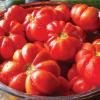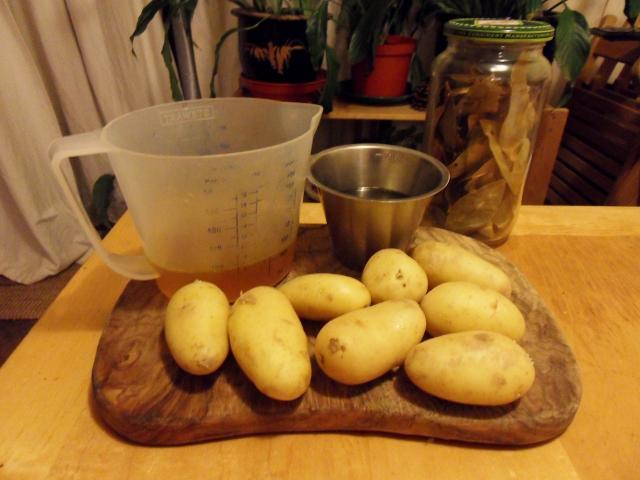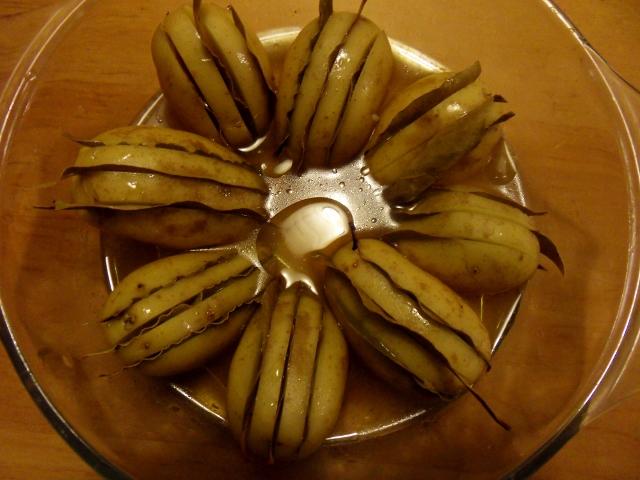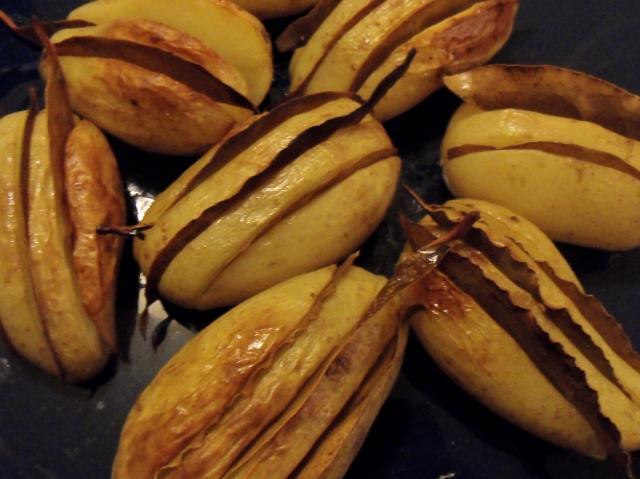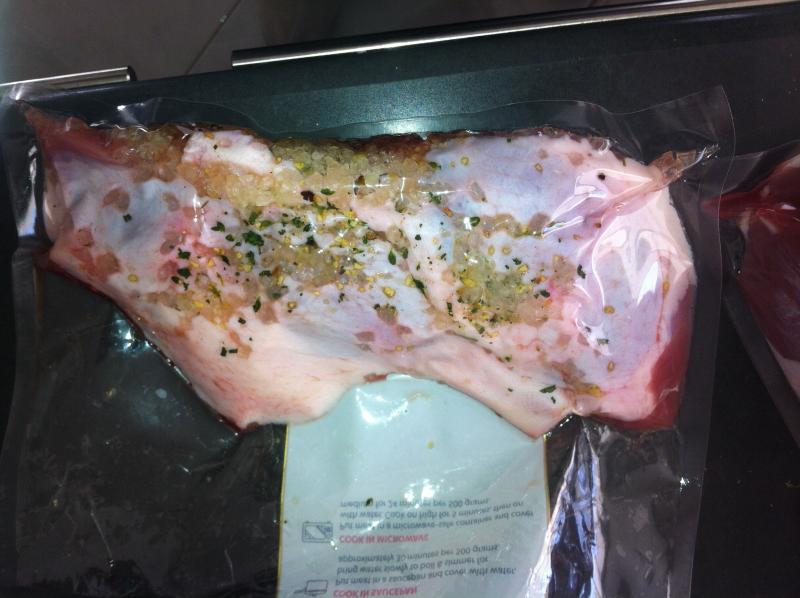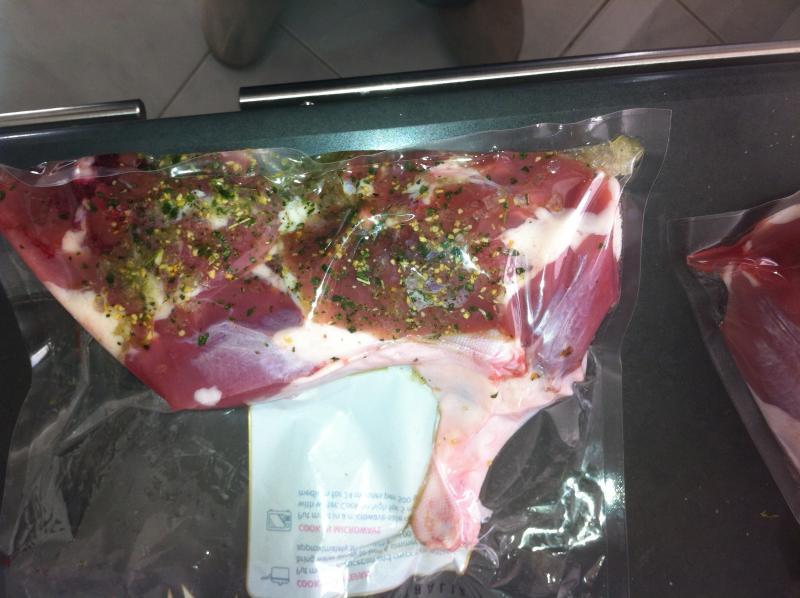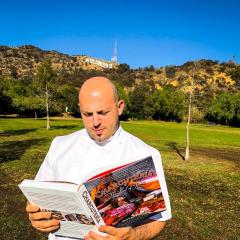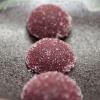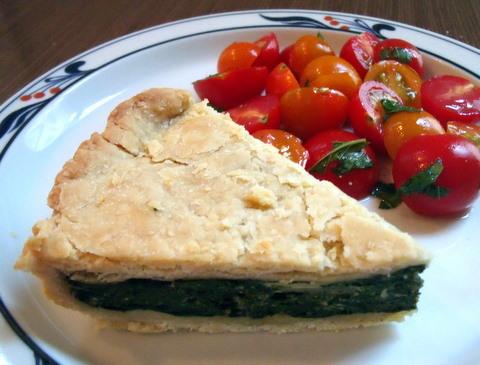Search the Community
Showing results for tags 'French'.
-
I will be in the South of France between Sept. and Oct., this fall. Having a house will make cooking a breeze. I am hoping to find 'Peche de Vigne' red-fleshed peaches in the market that time of year. I would like to make jam while I am there and bring it home. Has anyone seen these beautiful deep red peaches in the markets in Uzes? I found them in Paris last year, but that is out of my way. Many thanks!
-
I'm no kind of pastry chef or even a particularly keen pastry eater. (I tend towards the savoury rather than the sweet.), but I thought this article by the BBC would be interesting to all the eG pastry chefs. http://www.bbc.co.uk/news/world-europe-24609525. Nice to see innovation.
-
Here I am back again for my third food blog. I hope everybody will enjoy this one even though it going to be somewhat narcissistic. Please bear with me; I'll try not to be too boring. This blog is going to give my food/cooking history over the years. Because I'm older than dirt that makes for a lot of history. Monday will have me born & my food history up to 1980. Then a decade a day up to Friday and a close off on Saturday. As this is my personal food history elements of my life outside food will have to be included. I'll keep these to a minimum, but they will be necessary to provide context to the food history. What I'll do in answer to questions or comment is the following: (pretty standard, but I like things to be clear.) - I'll answer if I can. - If the subject is too personal or somewhat off topic I'll answer, but either deflect or steer back on topic in my answer. - If really out of line I'll just ignore the question/comment. Equally, I'll do my best to stay on topic. I really don't think that PM's are appropriate when discussing a food blog so I'd like everything to be out in the open. If you have questions that are off topic in regard to food or my food history, but pertinent to France, living or visiting here then by all means PM me. Enough about that. In this blog I'm going to not only take you on a culinary journey, but a physical one as well. The USA to Spain then Spain back to the USA then the USA to Belgium then Belgium to England then England to the USA then back to England then back to the USA and finally to France. There's Japan and Asia squeezed in somewhere as well. I've travelled a bit. At a class reunion a few years ago somebody asked me why I'd travelled so much? My answer then and now is: "I needed to keep one step ahead of the sheriff" Until tomorrow. I'm going to have fun with this. My autofoodography? My cusineography? You name it. PS: Having looked at what I've written I've decided that its too literary. Thus I'm going to post topical ( i.e. what's happening this week) inputs which will be far more pictorial. PPS: Yes, I do have a mystery object. Wait for it.
-
It looks like my wife and I will be going to Paris in January. While there I'd like to have duck in press, or whatever it's called, like at Alinea Paris 1906 and on Andrew Zimmern. Any suggestions for places?
-
I thought I'd learn some more precision and improve my method of cooking vegetables, so I recently got this book. The recipes aren't complicated. Following the recipes is the tricky thing; I'm a throw-in-a-bit-of-this-and-a-bit-of-that-and-see-what-happens kind of cook. I'll write what I think of the book when I've tried a few more of the recipes. For now, here's the first one I made: Pommes rôties au laurier - roast potatoes with bay The first step in this recipe is to slit the potatoes (I used Exquisas) and slip some slivers of bay inside the incisions. Then you roast them in a mixture of stock and olive oil. Here they are ready to go in the oven: The unusual thing about these roast potatoes is that they're half-way submerged in liquid at the start of cooking. The plan is for the stock to boil off and the potatoes then to roast in the oil; you don't parboil the potatoes first. It's really more of a braise. After 40mins in the heat: The potatoes are very tender after 40mins bubbling away in their bath. They taste - and you'll hardly credit it - of bay, so can make friends with any dish that likes bay. The flavour is pronounced, but perhaps not as much as you would expect with that many leaves getting involved. They are also attractive to look at. On the other hand I had to pour the stock off for the final part of cooking as it didn't evaporate as intended. I will try the recipe again with larger potatoes and a shallower dish - the size and shape of the vessel and the vegetables are left to the imagination by the recipe. That meant pouring off the oil too, which probably affected the texture at the end. There was also a bizarrely large quantity of oil specified so I only used about a fifth of it. The potatoes taste rather one-dimensional; I would perhaps prefer them with some garlic slices stuffed inside as well. We ate them with a green salad and flageolet beans, with a French Domaine Vocoret Chablis in the glass.
- 22 replies
-
- 1
-

-
- Vegetarian
- French
-
(and 1 more)
Tagged with:
-
Hi all, I am a first timer with regard to making confit duck legs. Living out in the sticks, I cannot readily get fresh duck, so have procured some frozen white pekin duck legs. I have defrosted them, trimmed off the excess fat to render, salted them heavily with sea salt, bay leaves, thyme, garlic, juniper berries and pepper and vacuum sealed them. I intend to leave them to cure for twelve hours in the fridge, unpack and rinse then cook sous vide at 78 degrees C for 12 hours. The photos are just after packing. My main questions are: How much liquid should be extracted from the legs? Should I include further seasonings in the bags when cooking? Is 12 hours curing adequate? How long should I let it rest before consumption? I have trawled the forums and google, and I am finding so much conflicting information. Thanks Simon
- 4 replies
-
- Charcuterie
- French
-
(and 1 more)
Tagged with:
-
Hello All! I wanted to share some great news-- my friend, French cook and culinary instructor Kate Hill, is bringing famed butcher and charcuterie master Dominique Chapolard for a bunch of workshops. There's still seats available at some of the sites--here is a link with the details: http://kitchen-at-camont.com/2013/02/24/two-day-workshops-in-the-usa-the-french-pig-making-farmstead-charcuterie/ TTFN, jeff
-
- Charcuterie
- French
-
(and 1 more)
Tagged with:
-
This is probably the most delayed dining report ever to appear on eGullet. We went to Paris in May of 2011 and I am just now getting to the point of this report. What can I say – life intervened. But some folks are still PM’ing me with hints about this report, so I thought I’d go ahead for anyone who is interested. We got lots of help and advice on the trip before going from eG folks, especially Forest who we were fortunate enough to meet and have dinner with. If you want to see the England part of our trip you can start here: http://forums.egullet.org/topic/139686-england-trip-report/ Wednesday 5/25/2011 That morning we took the train from St. Pancras station in London to Gard de Nord in Paris. We left so early that we didn’t have time to stop for a last English breakfast and had to make do on the train with a Crunchy, an apple and a pain au chocolat. Train food being train food, the Crunchy was the best part! Arriving in Paris was otherworldly. Everywhere we went in England felt like my natural home, but Paris was ‘foreign’ in a very special and wonderful way. You must remember that this was the first time I’d ever been anywhere that English wasn’t spoken. It was exciting and scary all at once. My Mary Tyler Moore moment as the fact of actually being in Paris really washed over me: 25-20m by ozisforme, on Flickr Our hotel was the Familia in the Latin Quarter on rue des Ecoles. Family owned, small and charming with a wonderful, welcoming and helpful staff. When the young lady who served us coffee and croissants in the mornings realized that I didn’t like coffee, she brought me (unasked) fabulous hot chocolate every morning. After checking in and hurriedly dumping our luggage we hit the street. We were still ravenous after our train snack, hour long taxi wait at the station and open mouthed drive through Paris so we stopped at the first place that smelled good and bought two quiches to eat as we walked: 25-20k1 by ozisforme, on Flickr A mushroom for Mr. Kim and a Lorraine for me: 25-20k2 by ozisforme, on Flickr Not fabulous, but perfectly good and much better than any street food that we are used to. We took a bus to the Eiffel Tour area. And, as an aside, we found the Paris bus and Metro system incredibly easy to use. Mr. Kim has a little French and I can say “hello”, “goodbye” and “thank you” and recognize lots of menu French, but even so I think that I could have gotten around on my own fairly well, I think. I was raised in Washington DC and that Metro is supposedly based on the Paris one. I think it must be true because I found the maps very familiar. We walked and gawped and grinned for some time. I loved finding the food stores and wished I had a kitchen: 25-33kby ozisforme, on Flickr 25-34kby ozisforme, on Flickr 25-35kby ozisforme, on Flickr And, of course, the bakeries: 25-36kby ozisforme, on Flickr 25-37kby ozisforme, on Flickr Some of the canned goods gave us a bit of a giggle: 25-56k2by ozisforme, on Flickr 25-56k3by ozisforme, on Flickr The food that French people don’t want us to know about! And, dear Lord, the cheese shops: 25-56k4by ozisforme, on Flickr Since we were taking an evening Seine cruise, we had an early dinner at Café Constant: 25-61k9iby ozisforme, on Flickr I’m sorry that I can’t remember who recommended this to us, but thank you! Every single dish was excellent. And the restaurant itself was charming with a nice mix of old and modern: 25-61k9bby ozisforme, on Flickr 25-61k9aby ozisforme, on Flickr We had a nice chat with the waitress and bartender while we were waiting for our table and it turned out that the waitress had worked in NYC for some time. Again, as I noted in my England report, folks on my side of the ocean don’t do near as much traveling as the British and French folks that we met. I started out with Bisque de crustaces aux queues d’ecrevisses a la crème legere: 25-61k9dby ozisforme, on Flickr Creamy shellfish bisque with crayfish tails. Perfect. So light and intensely flavored with the shellfish. Mr. Kim’s starter was Terrine of ‘Kako’, pressed foie gras and pork shin, lentil salad: 25-61k9eby ozisforme, on Flickr No idea what ‘Kako’ is, but this was stellar. Albeit a tad scary looking to a fellow raised on middle class American food, but he bravely tucked in and cleaned his plate! Mr. Kim’s main was duck and potato pie with crispy apples: 25-61k9fby ozisforme, on Flickr Perfect pairing and really good. My main was veal cutlets from the Basque country with white Tarbais beans: 25-61k9gby ozisforme, on Flickr Just gorgeous. Tender and flavorful and the beans were so perfectly cooked firm, tender and each one separate. And that little wedge of lightly grilled romaine on top: 25-61k9hby ozisforme, on Flickr was just astonishing in its simplicity. I’d love to know how that was done. Of course, I couldn’t possibly find such perfect little lettuces in Richmond VA, so I’ll just have to make do with the memory. More than a year later, I can still feel the texture and taste it. The cruise was wonderful. One of those things that seem slightly too touristy before you go, but something that I’d recommend to anyone visiting Paris for the first time. Especially if you only have 2 and a half days there. Since it was an evening cruise, we got to see Paris light up for the night. Breathtaking! After the cruise, we walked along the Seine and took the Metro to the Arc de Triomphe and wandered down the Champ-Elysees. I ended up having a head cold for most of the trip (irritating, but not bad) and was hoping to find something like Sudafed. Just down from the Arc is the Pharmacie du Drugstore des Champs-Elysées. The sign indicated that this was an ‘American Drugstore’. Translation is everything. This was NOTHING like an American drugstore. Gorgeous place with little specialty shop-type areas, amazing confections, Joël Robuchon’s L’Atelier in the freaking basement. Tres posh. But alas, no Sudafed. At least not that we could find. One of the travel guides that we read said that when in Europe resistance to McDonald’s was futile. That, no matter what we thought ahead of time, no matter how lofty our culinary standards, we’d end up in a McDonald’s. Primarily because of the bathrooms. Once inside, it posited, we’d succumb to the familiar fragrance and the cheap food. Well, we didn’t eat there, but strolling along the Champs-Elysées, we DID need a bathroom and lo and behold there was McD’s. So, we’ve been into a McD’s in Paris. But not even a cup of coffee passed our lips. We felt like we’d passed some arcane test. Cab ride back to the hotel – around the Place de la Concorde, past the Louvre, across the Pont Marie and into the Latin Quarter. To our first view of Paris at night from the balcony of our room: 25-150kby ozisforme, on Flickr Coming up - first full day in Paris and my favorite meal.
-
There's been a lot of discussion about pâte à choux technique recently. It's a tricky dough, to be sure. But what are you doing with it? Does everyone just make the traditional éclairs and cream puffs, or are there more adventurous types making glands, salambos or the elusive divorce? Is nobody game enough for the croquembouche? (Sorry for the French links, I couldn't find anything in English) For my two centimes, here's an old favorite: the Paris Brest (originally posted here). Makes a great birthday cake. Bon appétit.
-
This past Saturday, we had an amazing 9 course tasting meal at the Breton restaurant La Porte in Montreal. It was the perfect way to celebrate our tenth anniversary. The dessert was a Kouigne-Amann, served with a salted caramel sauce and a buttermilk sorbet. I'd never heard of this dessert, much less tasted it, and it was divine. During dinner, we talked about what we wanted to do before our 20th anniversary. For one of my goals, my wife has set me the task of learning how to make a perfect Kouigne-Amann. Can anyone recommend some top quality Breton cookbooks? In English or French? (Preferably French?) Thanks in advance.
-
When a white veal stock ends up too dark and opaque, is there a way to rescue it and remove some of the discoloration? Perhaps by clarifying it with some ground veal and egg whites, like you'd do for a consomme? Some background: I've been going through a bit of a classical French phase for the past few weeks, and having recently come upon a great source for veal bones, I've been venturing into making white veal stock as a basis for some classical sauce experiments. I made my first batch last week, and it turned out perfect. I used bones and shanks of uniform size with a split calf's foot, blanched everything according to the guidelines in the French Laundry cookbook, replaced the water, rinsed everything, and then cooked it at 170 degrees F for 8 hours. The stock was clear, with a wonderful golden color and great body, and had an almost custardy aroma. Totally different from and much more subtle than white chicken stock. Anyway, last night I made a bigger batch with larger, unbroken shank bones, among other things. I sensed I was in for trouble when the bones threw off so much blood during the blanching phase that the water turned bright crimson and then dark brown-gray. I threw out the blanching water again, rinsed the bones, and started the stock, but I think the larger bones continued to throw off raw blood into the stock, darkening the end product. Also, I cooked the stock at a lower temperature (160) this time for ten hours--perhaps not hot enough for the proteins to coagulate out of the stock? I was surprised at how little scum rose to the surface throughout the entire process.
-
Well, here I am again. It’s been just over 5 years since I last did a food blog. I’m excited and looking forward to doing this one just as I was in 2007! First, an update in general: We’re all well; Linda, Rupert and I. I’ve had a couple of minor strokes, but the magnificent French medical system saw me through those with no permanent damage. We’re still living in France and still loving it. We have moved though; all of about 6 miles. Our farmhouse was just too big and too expensive to run so we sold it. Linda & I now dance a little jig when the energy bills come in. It makes up for the lousy exchange rates! Our ‘new’ house is modern and somewhat smaller than the farmhouse. We still have 1 ½ acres, a pool and plenty of room. We are extremely happy with the move. Our ‘new’ village is just great very friendly. It’s unusual in that it’s actually laid out on a square grid. 400 year old town planning in action. We have a good village shop/ bakery. They made a really nice whole grain loaf in addition to all the normal sizes & shapes of French loaves. We also have small restaurant. Not likely to get any Michelin stars, but one can get a nice meal. They make a wonderful bread pudding. Our newest addition is a small food boutique, only open two days a week. They sell only local produce, fruits, vegetables, sun flower oil, pates, fois gras, a bit of wine and a few herbs. Local enterprise at its most local. I make a point of going in every week. More later, but let’s talk about food. I’ll start by going to the Sunday market in Saint Antonin Noble Val. St Antonin is a very old, very beautiful town right on the Aveyron river about 15 minutes away. Their Sunday market is great, but to be avoided during the summer months due to the crowds and lack of parking. Once we get to October the crowds thin out and the locals return to shop & to gossip. Gossiping being the great French pastime as it is in most countries. I’ll post about the market visit with pictures separately.
-
Off to Paris next weekend for the first time in a couple of years. Apart from having a good time, celebrating aniversaries, etc. my chief interests are bread and food related. I know the main kitchen shops and Librairie Gourmande, and I've done the famous boulangeries but does anyone have any suggestions or personal favourites or new arrivals in these fields? Plus, this time we're not flying, so can stagger back on Eurostar with a decent tagine in addition to the Martinique rum. Where's the best place reasonably near the centre to find North African cookware? Thanks Mick
-
Hi everyone, I'd like to make some eclairs to take to an event with lots of people bringing food - because there'll be a variety of (tasty) stuff I'd like to make my eclairs really small so they're not too filling and people can try them (also I think they'll look cute). Is there any reason I couldn't pipe out very skinny choux lines and hopefully end up with dainty little puffs? Ideally the final baked size would be about 8 - 10cm long and less than an inch wide... but i'm wondering if they may not expand properly or have a solid shell or something... anyone know? Cheers, Stuart
-
Hi everyone, I'm hoping that I can get some up-to-date information for my vacation in France next month. I have some draft ideas (and a reservation for lunch at Olivier Roellinger's place ) but I'd like to hear where you'd recommend for any food-related topic. We'll be staying on the coast near Caen for a few nights to begin, then MSM for a night, then Rennes for a night, before driving on to Brittany for a week. We'll be staying roughly between Lorient and Pontivy while we're there. We're planning on driving back (to Germany) via Rouen and Champagne. On the list so far are: Calvados, cider, and cheese-tasting in Normandy Roellinger, obviously, Chez Jacky and Anne de Belon when we're in Brittany I've read some recommendations online, and have the Michelin Red Guide, but I'd love some recommendations for anywhere from Honfleur/Lisieux in the east to Quimper in the west (the northern coast of Brittany, including places like St. Brieuc, will be a little too far away I think but generally distances aren't a problem), and any hidden gems or less well-known Champagne producers that are worth a visit would also be gratefully received. I'm happy to share my experiences when I get back, and I'll post some other places we're considering in due course. Thanks in advance, IA
-
Please excuse my ignorance; I do not cook much with pork. I have a recipe in French that calls for "ventreche de cochon". I know this translates literally to "belly of pork". However, I am wondering if this is specific to raw, or some sort of cured product. The recipe calls for the ventreche de cochon to be sliced paper thin on a deli slicer, and it is briefly sauteed (3 minutes) into a fricassee of escargot. Does raw pork belly seem right to use in this scenario?
-
Help, I am having a dinner party on Thursday night which is difficult for me as I work all day everyday. I am making lie flottante, I am going to do the creme anglais sous vide on Wed. I want to make the meringues early, but don't know how long they will keep. I also have a chamber vacuum sealer and am having trouble keeping the liquid in the bags upon sealing. All help is greatly appreciated. Ike
-
I'm cooking for a group of 20 soon and planning to do Coquille St. Jacques. After looking through dozens of recipes, I'm still torn between the a la Parisienne and Provencale styles. Serving with a crustless asparagus quiche and pea shoot salad. As a spring event I want the scallops to be somewhat light and fresh. Your comments and suggestions please.
-
So I know that mirepoix -- the mix of onion, celery and carrots typical in French cooking -- is supposed to be the backbone or starting point of stocks, broths, soups and sauces. Having learned much of my cooking from traditional texts like Mastering the Art of French Cooking, I absorbed that lesson. For years I made my stock with the trio and then used that for soups and sauces. Then I started making my stock without anything but meat and bones and decided it made for a much better result -- if I want the taste of vegetables I add them later. I gradually stopped automatically using mirepoix and found that in most cases, it made an improvement in my cooking. I was reminded of this recently when I made tomato soup using a recipe I found that called for the usual mix of onion, carrot and celery. I figured I'd give it a try again, but sure enough, it wasn't great. Not only was the tomato flavor severely muted, but since the soup was only partially blended, it also left little bits of carrot and celery in the soup, which were offputting. I'm glad I gave it a try, because now I know I was right. No more mirepoix for me (at least not automatic mirepoix). Am I the only one?
-
So here we are in Beaune, and loving it. Cooking to our heart's content (couldn't tear ourselves away from the Saturday market). But I am shocked at the lack of great breads and pastry! In four days, I've tried three different boulangeries/patisseries. The croissants - bleh. None of them would I describe as "buttery" (and I did order the "au beurre"). The breads, not one of four loaves would I write home about. Although one pain au chocolat looked promising, I lifted it and was blown away by how heavy it was...and it was not due to an excess of chocolat! So my questions are: 1) Does anyone know a great boulangerie/patisserie in Beaune; and 2) Do all the talented bakers head straight to Paris?
-
Boyfriend and I rented an apartment in Beaune for the month of April. I still can't believe it. Markets and cooking and baking and eating and speaking and eating (he doesn't drink wine!) and walking and more markets and brocantes and cooking and eating. Finding the best croissant. The best fromagerie. You get the picture. We just want to explore every day. Maybe a cooking class if there is something interesting looking. We won't have a car. May rent bikes. Lots of buses and trains. What can't we miss in Burgundy? Thanks for any and all information provided!
-
In the Proencal author Jean Giono's short story "The solitude of Compssion" which is set in Provence a cure has been given a bundle of pig tripes by his brother. His housekeeper initially starts it sizzling in fat with "bits of purple liver like flowers and rice on the stalk". When the cure asks his housekeeper what she's making she responds "it's a picoche", and than pours a a "thin stream of thick wine with the smell of wood root" into the pan. Can anyone tell me what the housekeeper is making
-
Hi everyone, I was hoping you help me recreate Joel Robuchon's mini french baguettes. I have had them many times in l'atelier in Las Vegas, and I think it is the tastiest baguette I have ever had. This is what they look like: I have looked for the recipe all over the internet with no luck. Any help or suggestion would be greatly appreciated!!
-
While reading a cookbook recently, I came across a reference to "the nine traditional departments" in the French kitchen, all "run by independent sous-chefs - from the saucier to the rôtisseur." I sat down and tried, but couldn't think of all nine departments, and none of my books seem to list them as such. Could anyone tell me what they are? Or are there more/less than nine?
-
I’m curious if others have made or sampled tourte aux blettes—a double crusted sweet swiss chard tart that’s a Mediterranean specialty. The other day I finally got around to making one. The concept has always intrigued me but I’ve never really been convinced that I want sugar with my chard. This summer my garden’s overflowing with chard so it seemed like the time. Only when I started scanning my recipes did I realize how many variations existed for this tart—from mostly savory to unabashedly sweet. Raisins seem to be the one universal addition, sometimes pine nuts. Francois Payard calls for pastry cream and rum, Daniel Boulud adds cream, honey, and orange zest. The other variable seems to be the dough. Payard and Boulud use sweet pastry dough, while others use dough made with olive oil—some with eggs, some without. For my first try, I opted for a mostly savory version, adding a little honey for sweetness (I dislike raisins) and some pine nuts. For the dough, I went with basic olive oil dough, which I’d never made before. I liked the end result very much, but to my surprise think that next time I’ll move further in the sweet direction. The contrast wasn’t jarring, as I’d imagined, rather the honey nicely balanced the earthy chard. Likewise, I’ll use a lighter dough, probably still olive oil-based but with eggs. I’m not quite ready for pate sucre or pastry cream with my chard.


